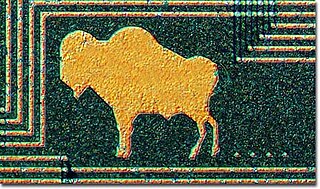
An integrated circuit or monolithic integrated circuit is a set of electronic circuits on one small flat piece of semiconductor material, usually silicon. Large numbers of miniaturized transistors and other electronic components are integrated together on the chip. This results in circuits that are orders of magnitude smaller, faster, and less expensive than those constructed of discrete components, allowing a large transistor count. The IC's mass production capability, reliability, and building-block approach to integrated circuit design has ensured the rapid adoption of standardized ICs in place of designs using discrete transistors. ICs are now used in virtually all electronic equipment and have revolutionized the world of electronics. Computers, mobile phones and other home appliances are now inextricable parts of the structure of modern societies, made possible by the small size and low cost of ICs such as modern computer processors and microcontrollers.
Electronic design automation (EDA), also referred to as electronic computer-aided design (ECAD), is a category of software tools for designing electronic systems such as integrated circuits and printed circuit boards. The tools work together in a design flow that chip designers use to design and analyze entire semiconductor chips. Since a modern semiconductor chip can have billions of components, EDA tools are essential for their design; this article in particular describes EDA specifically with respect to integrated circuits (ICs).
An industrial design right is an intellectual property right that protects the visual design of objects that are purely utilitarian. An industrial design consists of the creation of a shape, configuration or composition of pattern or color, or combination of pattern and color in three-dimensional form containing aesthetic value. An industrial design can be a two- or three-dimensional pattern used to produce a product, industrial commodity or handicraft.
Industrial property is one of two subsets of intellectual property, it takes a range of forms, including patents for inventions, industrial designs, trademarks, service marks, layout-designs of integrated circuits, commercial names and designations, geographical indications and protection against unfair competition. In some cases, aspects of an intellectual creation, although present, are less clearly defined. The object of industrial property consists of signs conveying information, in particular to consumers, regarding products and services offered on the market. Protection is directed against unauthorized use of such signs that could mislead consumers, and against misleading practices in general.

The Canadian Intellectual Property Office is responsible for the administration and processing of the greater part of intellectual property (IP) in Canada. CIPO's areas of activity include patents, trademarks, copyright, industrial designs and integrated circuit topographies. Structurally, CIPO functions as a special operating agency (SOA) under Innovation, Science and Economic Development Canada. CIPO is based in Gatineau, Quebec, part of the National Capital Region. CIPO’s current interim Chief Executive Officer is Konstantinos Georgaras.
In electronic design, a semiconductor intellectual property core, IP core, or IP block is a reusable unit of logic, cell, or integrated circuit layout design that is the intellectual property of one party. IP cores can be licensed to another party or owned and used by a single party. The term comes from the licensing of the patent or source code copyright that exists in the design. Designers of application-specific integrated circuits (ASIC) and systems of field-programmable gate array (FPGA) logic can use IP cores as building blocks.
The Integrated Circuit Topography Act is legislation passed by the Parliament of Canada in 1990 that regulates the intellectual property of integrated circuit topographies. It came into force in 1993. The Act provides exclusive rights for the creator of the integrated circuit topography and remedies to deter infringement. The exclusive right is transferable. To receive the exclusive right to an integrated circuit topography the topography must be registered at the Canadian Intellectual Property Office. Between 1993 and 1999 there were about 38 registrations under the Act.

Integrated circuit design, or IC design, is a sub-field of electronics engineering, encompassing the particular logic and circuit design techniques required to design integrated circuits, or ICs. ICs consist of miniaturized electronic components built into an electrical network on a monolithic semiconductor substrate by photolithography.

Chip art, also known as silicon art, chip graffiti or silicon doodling, refers to microscopic artwork built into integrated circuits, also called chips or ICs. Since ICs are printed by photolithography, not constructed a component at a time, there is no additional cost to include features in otherwise unused space on the chip. Designers have used this freedom to put all sorts of artwork on the chips themselves, from designers' simple initials to rather complex drawings. Given the small size of chips, these figures cannot be seen without a microscope. Chip graffiti is sometimes called the hardware version of software easter eggs.
Intellectual property law in Romania has developed significantly in the period since the Romanian Revolution of 1989 because of the need to enforce various regional and international treaties and agreements, such as the Agreement on Trade-Related Aspects of Intellectual Property Rights (TRIPS), the European Directives on Biotechnological Inventions, on Trademarks and Geographical Indications, and on Supplementary protection certificates, the Trademark Law Treaty, the Patent Law Treaty, and the European Union regulation on the Community Trademark, and the need to harmonize domestic patent law with the European Patent Convention (EPC) and with the European Union.

The Copyright, Designs and Patents Act 1988, also known as the CDPA, is an Act of the Parliament of the United Kingdom that received royal assent on 15 November 1988. It reformulates almost completely the statutory basis of copyright law in the United Kingdom, which had, until then, been governed by the Copyright Act 1956 (c. 74). It also creates an unregistered design right, and contains a number of modifications to the law of the United Kingdom on Registered Designs and patents.
"Author's rights" is a term frequently used in connection with laws about intellectual property.
In copyright law, related rights are the rights of a creative work not connected with the work's actual author. It is used in opposition to the term "authors' rights". Neighbouring rights is a more literal translation of the original French droits voisins. Both authors' rights and related rights are copyrights in the sense of English or U.S. law.
The following outline is provided as an overview of and topical guide to intellectual property:

The Semiconductor Chip Protection Act of 1984 is an act of the US Congress that makes the layouts of integrated circuits legally protected upon registration, and hence illegal to copy without permission. It is an integrated circuit layout design protection law.
Bonito Boats, Inc. v. Thunder Craft Boats, Inc., 489 U.S. 141 (1989), is a decision of the United States Supreme Court holding a state anti-plug molding law preempted because it partially duplicated and therefore interfered with the balance Congress had struck by federal patent law. The decision reaffirmed the Supreme Court's earlier decision in Sears, Roebuck & Co. v. Stiffel Co. (1964), which held a state unfair competition law preempted on the same ground.
Iran is a member of the WIPO since 2001 and has acceded to several WIPO intellectual property treaties. Iran joined the Convention for the Protection of Industrial Property in 1959. In December 2003 Iran became a party to the Madrid Agreement and the Madrid Protocol for the International Registration of Marks. In 2005 Iran joined the Lisbon Agreement for the Protection of Appellations of Origin and their International Registration, which ensures the protection of geographical names associated with products. As at February 2008 Iran had yet to accede to The Hague Agreement for the Protection of Industrial Designs.

Canadian intellectual property law governs the regulation of the exploitation of intellectual property in Canada. Creators of intellectual property gain rights either by statute or by the common law. Intellectual property is governed both by provincial and federal jurisdiction, although most legislation and judicial activity occur at the federal level.
The Industrial Designs Act, 2003 is a Ghanaian act to revise the enactments on the protection of industrial designs and to provide for related matters. The Act is one of the Seven Acts that exist to protect Intellectual Property Rights in Ghana namely; Protection against Unfair Competition Act, 2000 ; Industrial Designs Act, 2003 ; Geographical Indications Act, 2003 ; Patents Act, 2003 ; Trademarks Act, 2004 ; Layout-Designs (Topographies) of Integrated Circuits Act, 2004 and Copyrights Act, 2005.
The Constitution of Azerbaijan generally recognizes the right to intellectual property (IP), and ensures the protection of IP rights of all persons. In order to clarify the norm of Constitution, and establish the legal basis of the protection of intellectual property rights, the parliament of Azerbaijan approved some laws, and ratified international agreements.






